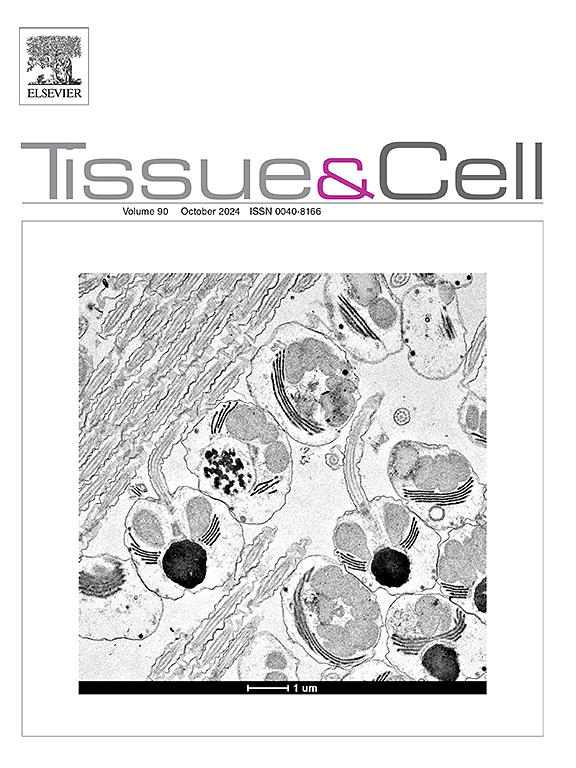Topical administration of Juniperus polycarpos K. Koch extract triggered wound healing by decreasing inflammation and accelerating cell proliferation in diabetic rat model
IF 2.7
4区 生物学
Q1 ANATOMY & MORPHOLOGY
引用次数: 0
Abstract
One of the primary difficulties for individuals with diabetes is the development of chronic wounds. The current research sought to investigate the potential antioxidant and anti-inflammatory properties of Juniperus polycarpos K. Koch (JP) extract when topically applied in diabetic wound healing. A total of 75 diabetic rats were randomly assigned into the control group, eucerin group, 2 % Juniperus polycarpos K. Koch ointment (JP 2 %) group, 5 % Juniperus polycarpos K. Koch ointment (JP 5 %) group, and phenytoin group. Skin samples were obtained on days 7, 14, and 21 to assess them through histological, molecular, and biomechanical methods. The results indicated that in the treatment groups, there was a significant enhancement in the rate of wound healing, the volumes of newly formed epidermis and dermis, the overall number of fibroblasts and blood vessels, collagen deposition, and biomechanical parameters compared to the control and eucerin groups, with the most pronounced changes observed in the JP 5 % group. Furthermore, there was a significant rise in the transcripts of TGF-β and VEGF genes in the treatment groups compared to the control and eucerin groups, with the highest levels of expression seen in the JP 5 % group. In the JP 5 % group, there was a significantly larger reduction in TNF-α and IL-1β expression, along with a decrease in neutrophil count, compared to the other groups. These findings confirmed that the topical application of JP extract, particularly at a 5 % concentration, significantly accelerated the healing of diabetic wounds.
外用刺柏提取物可减轻糖尿病大鼠模型的炎症反应,促进细胞增殖,从而促进创面愈合
糖尿病患者的主要困难之一是慢性伤口的发展。本研究旨在探讨朱柏多糖(Juniperus polycarpos K. Koch, JP)提取物局部应用于糖尿病伤口愈合时的潜在抗氧化和抗炎特性。将75只糖尿病大鼠随机分为对照组、优素林组、2 %松柏软膏(JP 2 %)组、5 %松柏软膏(JP 5 %)组和苯妥英组。在第7、14和21天获得皮肤样本,通过组织学、分子和生物力学方法对其进行评估。结果表明,与对照组和eucerin组相比,治疗组在伤口愈合率、新形成表皮和真皮层的体积、成纤维细胞和血管的总数、胶原沉积和生物力学参数方面均有显著提高,其中JP 5 %组的变化最为明显。此外,与对照组和eucerin组相比,治疗组中TGF-β和VEGF基因的转录本显著增加,其中JP 5 %组的表达水平最高。在JP 5 %组中,与其他组相比,TNF-α和IL-1β表达明显减少,同时中性粒细胞计数减少。这些发现证实,局部应用JP提取物,特别是在5% %浓度下,显着加速了糖尿病伤口的愈合。
本文章由计算机程序翻译,如有差异,请以英文原文为准。
求助全文
约1分钟内获得全文
求助全文
来源期刊

Tissue & cell
医学-解剖学与形态学
CiteScore
3.90
自引率
0.00%
发文量
234
期刊介绍:
Tissue and Cell is devoted to original research on the organization of cells, subcellular and extracellular components at all levels, including the grouping and interrelations of cells in tissues and organs. The journal encourages submission of ultrastructural studies that provide novel insights into structure, function and physiology of cells and tissues, in health and disease. Bioengineering and stem cells studies focused on the description of morphological and/or histological data are also welcomed.
Studies investigating the effect of compounds and/or substances on structure of cells and tissues are generally outside the scope of this journal. For consideration, studies should contain a clear rationale on the use of (a) given substance(s), have a compelling morphological and structural focus and present novel incremental findings from previous literature.
 求助内容:
求助内容: 应助结果提醒方式:
应助结果提醒方式:


